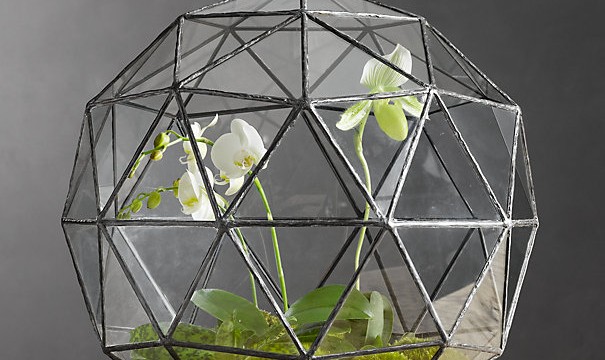
Blue Rabbit Project: Making Mini Worlds
How can I make people feel more connected with the earth, with creativity, and with themselves in an easy, practical, and sustainable way?
In a world of so much stuff, what idea is worth making in a 3D printer? This question threw my mind into loops and holes and took me into a new world of thought. I jumped around and toyed with many ideas, but I knew I wanted to create something that reminded people, or helped people realize their connection with nature, their connection with themselves as energetic beings, and connection with each other. I want to demonstrate in a beautiful way how we have moved into a makers world instead of a growing world, and how we need to balance our creations and our earths creations. Somehow, in the midst of a walking meditation in the woods with David Loy, I arrived at my idea, making terrariums.
In a world of so much stuff, I think art should always be created, especially sustainable art. When I look into a terrarium, I look into a little world, similar to a snow globe, and feel myself a creator of the world, but also know that the plants are growing themselves and that I can only seed or transplant them, but I cannot physically create them. In my project, I want to create a series of three different terrariums; The first terrarium will be completely filled with plants and pieces from the earth, to shape a romantic natural setting. The second will be a mix of earth objects and 3D printed objects, to form a setting that we are more 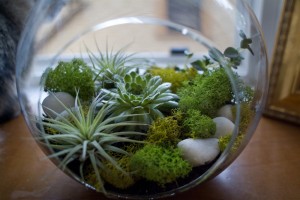 accustomed too; the mix of plants and our man made objects. The third will be a terrarium of entirely 3D printed objects, creating an artificial and hopefully futuristic scene. Looking at the sequence of the three terrariums, I am hoping the audience will experience the beauty of the natural world and the man made world, and see we must stay in the middle terrarium, where balance between us and nature is present.
accustomed too; the mix of plants and our man made objects. The third will be a terrarium of entirely 3D printed objects, creating an artificial and hopefully futuristic scene. Looking at the sequence of the three terrariums, I am hoping the audience will experience the beauty of the natural world and the man made world, and see we must stay in the middle terrarium, where balance between us and nature is present.
Terrariums are a practical, easy way to bring plants into our homes with very little maintenance. The more people are able to work with the earth and connect with the growing nature of plants, the more they are able connect with the growing nature within themselves and within the earth. With a terrarium, you don’t need a garden, or a certain climate, or in the case of air plants, you don’t even need soil. For the basic terrarium all you need is a container of any size, soil (except for air plants), plants, water, and a spot near some sunlight, and boom! You have a little ecosystem growing! In some cases, people even put lizards or small animals in their terrariums.
The way I am going to construct my terrariums is by 3D printing the outside container, adding the soil and plants, and then 3D printing the objects inside. The first won’t have any 3D objects inside, but the container will be 3D printed. The second will have plants and 3D printed objects inside, and the third will be completely filled completely 3D printed objects atop soil. The great thing about terrariums is you can make them entirely out of found objects, but the 3D printer allows much more freedom and creativity for this project. I have not fully decided upon the exact scenes I want to portray in each terrarium, but I going to allow that to grow through practicing what I could actually make in the 3D printers.
Rudolf Steiner said. “Art is one of the healthiest, most direct ways to arm and strengthen ourselves against the harmful influences of modern life.” (Art as Seen in the Light of Mystery Wisdom. Lecture) In the book The Secret Life of Plants, Peter Tomkin says, “The true matrix of human life is the greensward covering mother earth. Without green plants we would neither breathe nor eat.” (Tomkins, Intro viii) Scientists, philosophers, shamans, healers, and many more people agree that working with the land in any way increases healthier lifestyles, but not everyone has the time or space to work with, or even be near the land. For centuries people have seen art and creativity as a way to develop and heal, but not everyone has time or access to the arts. Terrariums are an easy way to blend gardening and art together, and can be done sustainably using recycled materials. While researching my project I found a Meditation and Ecology Center in Richmond, BC that is, “dedicated to inner and outer peace through meditation and to caring for our internal and external environments.” (http://www.sos.org/can/western/page/meditation-ecology-centre-richmond-bc.html). They are a multi faith organization that helps people better themselves through meditation and gardening. Their leader, Sant Rajinder Singh Ji Maharaj, has a poem on their website that described what I want my project to bring for me; a practice of meditation and transformation, while representing my idea in an artistic fashion. I want to show people an easy, practical, sustainable way they can incorporate this into their homes.
Ecology of the Soul
“There is a perfect balance in nature. Our
world, our environment, and nature itself form a
living interdependent system.
The perfect balance of nature which has
maintained life on our planet for millions of years
is being threatened by the very technology that
has transformed the world.
Concern for ecology has become one of the
main preoccupations of the world. Through the
simple process of meditation, we can bring peace
and ecological balance, not only to ourselves,
but to the whole planet.
It is my dream to bring about this harmony
on our earth.”
–Sant Rajinder Singh Ji Maharaj
Biblography:
- Website Title: Meditation & Ecology Centre
- Article Title: Science of Spirituality
- Date Accessed: October 19, 2014
Tompkins, Peter, and Christopher Bird. The Secret Life of Plants. New York: Harper & Row, 1973. Print.
Steiner, Rudolf. “Art as Seen in the Light of Mystery Wisdom.” Switzerland, Dornach. 14 Dec. 1914. Lecture.


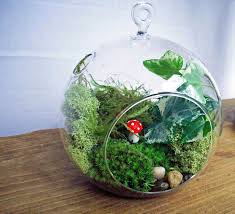
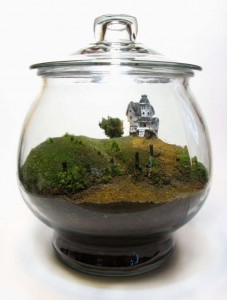
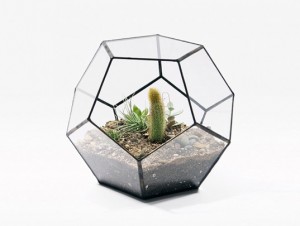
I really like that your idea revolved around more than just how to make a terrarium with a 3D printer, addressing sustainability as well as practicality. The images you used perfectly outlined the the objective you hope to achieve by the end of the quarter. You made your goals very well known, in three parts, and I am really interested to see the effect that each of these experimental terrariums has on people. Which design makes whom feel more at home? You made it clear throughout the writing that these practices can help one connect with nature, since we cannot just create it, and the importance of that in life. Would you also consider the act of making these terrariums a type of active meditation?
Yarden’s question is “How can I make people feel more connected with the earth, with creativity, and with themselves in an easy, practical, and sustainable way?”
The beautiful images give examples of the range of terrariums that can be created. It would have been great to see a 3d image of a light bulb or other container that she intends to print as a terrarium.
She is going to create terrariums that balance the delicate nature of ecology with the man made nature of technology.
She describes the importance of this idea by underscoring the importance of balancing ecology and technology, and the acts of growing and making, and their implications on the future.
The references cited offer support of the importance of art and nature. I would like to see how the world of 3D printing is already doing this. Who else is using 3D printing to bring art and nature into our lives?
Yarden will create a series of terrariums that demonstrate the need to balance ecology and technology, bringing meditation and transformation into everyone’s everyday lives.